Papers by Eunice D Vargas Valle

International Migration, 2025
Over the past two decades, more than half a million children -mostly born and educated in the USA... more Over the past two decades, more than half a million children -mostly born and educated in the USA- have arrived in Mexico from the USA because of their parents' return migration. The aim of this paper is to analyse the relationship between their national identification, school trajectories and US nationality in a border city with high return migration. The methodology is based on the analysis of a school survey and semi-structured interviews with transnational students. The results show that: binational identification was higher when students had intermediate schooling in both countries; identification with the USA decreased and identification with Mexico increased with more years in Mexican schools; and school trajectories were more relevant than nationality in defining binational identification. The majority of students identified as binational because their migration histories and transnational life experiences allowed them to be bicultural, despite the diffusion of mononational ideologies in schools.

US Citizenship for our Mexican Children! US-born Children of Non-Migrant Mothers in Northern Mexico
Journal of Borderlands Studies
We analyze the presence of non-migrant US-born children aged 0-4 in the northern states of Mexico... more We analyze the presence of non-migrant US-born children aged 0-4 in the northern states of Mexico and associated factors by parental nativity. Based on the 2020 Mexican Census, we describe the location, population size, and sociodemographic profiles of these children. We also estimate regression models to examine factors associated with children's US nativity. We found that US births to non-migrant mothers have become a more prevalent source of US-born children than return migration in recent years. Non-migrant US-born children slightly declined from 2010 to 2020 and continued to be concentrated in northern states, particularly in the border municipalities. Multivariate regression models reveal that, among children of Mexico-born parents, being non-migrant US-born was associated with higher levels of parental schooling, socioeconomic status, or cross-border employment. Births in the U.S. are more common among Mexican middle-upper status families suggesting a selection process that may contribute to social reproduction by increasing their children's future socioeconomic opportunities relative to Mexicoborn children. However, among those with US-born parents, US birth does not vary by socioeconomic status showing those with easier access to the United States and transnational social capital do not need additional resources to secure US citizenship.

Unauthorized Mexican-Born Immigrants, Occupational Injuries, and the use of Medical Services in the United States
International Migration Review
This article examines how unauthorized immigrant status is associated with the risk of suffering ... more This article examines how unauthorized immigrant status is associated with the risk of suffering a work-related accident or illness and with the use of medical services after experiencing an injury among Mexican immigrants in the United States. Using individual-level data on 81,004 Mexican immigrants who previously worked in the United States and were interviewed when they returned to Mexico in the Survey of Migration in the Northern Border of Mexico from 2010 to 2018, we estimate a series of probit models and nonlinear decompositions to analyze legal status differences in the incidence of occupational injuries among immigrant workers. The results show that among Mexican immigrants in the United States unauthorized status was associated with a greater probability of experiencing an occupational injury. The higher injury rate among unauthorized immigrants was partly driven by the fact that they worked more hours per day, more days per week, and were employed in riskier occupations th...

Family Separation and Remigration Intentions to the USA among Mexican Deportees
International Migration
Increasingly stringent immigration enforcement in the US interior has led to the deportation of l... more Increasingly stringent immigration enforcement in the US interior has led to the deportation of large numbers of long‐term Mexican immigrants with families in the USA. We analyse the statistical association between the intent to return to the USA and leaving minor children with spouses or other people in the USA among Mexican immigrants deported from the US interior in 2014–2018, and explore if this association varies by sex and year of deportation. We employ the deportees’ section of the Survey on Migration on Mexico's Northern Border. The results indicate that having left children in the USA considerably increases the likelihood of a plan to return to the USA, especially in the short term and when deportees left minor children with a spouse. Remigration plans were higher among women and slightly decreased over time among parents, suggesting a continued failure of policy to account for the family circumstances of immigrants.
OBETS. Revista de Ciencias Sociales, 2019
Se analiza la asociación entre la asistencia al prescolar de niños de 3 a 5 años y el estatus mar... more Se analiza la asociación entre la asistencia al prescolar de niños de 3 a 5 años y el estatus marital materno en México y se determina cómo esta asociación varía por nivel de educación y estatus socioeconómico de la madre. Con base en los microdatos del censo mexicano 2010, se emplea estadística descriptiva y modelos de efectos aleatorios. Los niños de las mujeres solteras, separadas y en cohabitación presentan menor asistencia escolar que los niños de las mujeres casadas. Sin embargo, para los niños de madres con altos niveles educativos estas desventajas disminuyen, o revierten para aquellos con madres divorciadas, excepto para aquellos con madres en cohabitación.
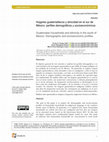
Estudios Fronterizos, 2019
El objetivo general de este artículo es analizar los perfiles demográficos y socioeconómicos de l... more El objetivo general de este artículo es analizar los perfiles demográficos y socioeconómicos de los hogares guatemaltecos por habla de lengua indígena en las entidades de la frontera sur de México. En particular, se explora cuántos hogares guatemaltecos están asentados, cómo se configuran y cómo se han integrado en términos estructurales, con base en la Encuesta Intercensal 2015. Para tal fin se emplea estadística descriptiva y un modelo de regresión logística multinomial. El análisis indica que los hogares guatemaltecos se concentran en áreas rurales, son numerosos y más jóvenes, y laboran principalmente en el sector primario. Su integración socioeconómica es desventajosa en rubros como las condiciones del empleo y de la vivienda y el acceso a servicios sociales. No obstante, los hogares guatemaltecos indígenas exhiben niveles más altos de integración social que sus contrapartes no indígenas en el acceso a la ciudadanía mexicana, vivienda y apoyos económicos gubernamentales.

Drug‐related violence and the decline in the number of Mexican cross‐border workers
Review of Development Economics, 2020
This study examines how variations in homicide rates in Mexico are associated with the likelihood... more This study examines how variations in homicide rates in Mexico are associated with the likelihood of participating in cross‐border work, that is, living in Mexico but working in the U.S. Based on Mexican census data from 2000, 2010, and 2015, and information on homicides, a series of ordinary least squares models are estimated to analyze the relationship between cross‐border commuting and homicide rates at the individual level. Fixed effects models are also estimated to study this relationship at the municipal level. The results show that from 2000 to 2010 the increase in homicide rates in northern border municipalities in Mexico reduced the likelihood of being a cross‐border worker, while from 2010 to 2015 the decrease in the homicide rate increased the probability that workers engage in cross‐border work. The decline in the number of cross‐border workers is likely in part a result of the escalation in drug‐related violence that may have led them to change their country of residence.
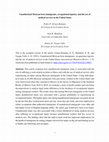
International Migration Review, 2023
This article examines how unauthorized immigrant status is associated with the risk of suffering ... more This article examines how unauthorized immigrant status is associated with the risk of suffering a work-related accident or illness and with the use of medical services after experiencing an injury among Mexican immigrants in the United States. Using individuallevel data on 81,004 Mexican immigrants who previously worked in the United States and were interviewed when they returned to Mexico in the Survey of Migration in the Northern Border of Mexico from 2010 to 2018, we estimate a series of probit models and non-linear decompositions to analyze legal status differences in the incidence of occupational injuries among immigrant workers. The results show that among Mexican immigrants in the United States unauthorized status was associated with a greater probability of experiencing an occupational injury. The higher injury rate among unauthorized immigrants was partly driven by the fact that they worked more hours per day, more days per week, and were employed in riskier occupations than authorized immigrants. If unauthorized immigrants were older and had higher levels of English-language ability, the injury gap would have been even larger. Unauthorized status was also associated with a lower likelihood of using medical services after suffering an occupational injury because unauthorized workers had less access to medical care. The findings show that the right to legal work has important implications for the health of immigrants by setting a higher risk level for injury on the job and limiting access to health care following such an injury.

Latin American Research Review, 2022
Con el retorno reciente de los migrantes mexicanos, miles de estudiantes con experiencia escolar ... more Con el retorno reciente de los migrantes mexicanos, miles de estudiantes con experiencia escolar en Estados Unidos se incorporaron a las escuelas mexicanas. El objetivo de este artículo es analizar la adaptación lingüística de estos estudiantes en una ciudad con alto retorno, Tijuana, México. Se utiliza metodología mixta que comprende el análisis de la Encuesta de Migración e Integración Escolar 2017, así como treinta y seis entrevistas semiestructuradas realizadas a estudiantes transnacionales en 2018 y 2019. Los hallazgos sugieren un proceso paulatino de aprendizaje del español y pérdida del inglés a mayor tiempo en México desde el último arribo, así como la existencia de competencias lingüísticas desiguales según la socialización escolar en cada país, el país de identificación cultural y nacimiento, el capital económico, social y cultural de los hogares, y los apoyos de maestros y compañeros. Se requieren políticas públicas que favorezcan el bilingüismo en las escuelas de ambos países.
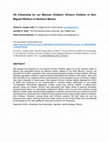
Journal of Borderlands Studies, 2022
We analyze the presence of non-migrant US-born children aged 0-4 in the northern states of Mexico... more We analyze the presence of non-migrant US-born children aged 0-4 in the northern states of Mexico and associated factors by parental nativity. Based on the 2020 Mexican Census, we describe the location, population size, and sociodemographic profiles of these children. We also estimate regression models to examine factors associated with children's US nativity. We found that US births to non-migrant mothers have become a more prevalent source of US-born children than return migration in recent years. Non-migrant US-born children slightly declined from 2010 to 2020 and continued to be concentrated in northern states, particularly in the border municipalities. Multivariate regression models reveal that, among children of Mexico-born parents, being non-migrant US-born was associated with higher levels of parental schooling, socioeconomic status, or cross-border employment. Births in the U.S. are more common among Mexican middle-upper status families suggesting a selection process that may contribute to social reproduction by increasing their children's future socioeconomic opportunities relative to Mexicoborn children. However, among those with US-born parents, US birth does not vary by socioeconomic status showing those with easier access to the United States and transnational social capital do not need additional resources to secure US citizenship.
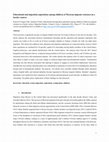
Migration Studies, 2021
There has been a significant increase in migrant children from the US living in Mexico in the las... more There has been a significant increase in migrant children from the US living in Mexico in the last two decades. This article analyses the association between transnational schooling and the education and migration aspirations (the country one wishes to live or work in) of lower secondary students in Tijuana, a border city with very high return migration. This article also addresses how education and migration aspirations are connected and the extent to which these aspirations are mediated by US-specific capital (US citizenship, having family members in the United States, English proficiency, and cultural identification with the United States). The analyses draw from the 2017 School Integration and Migration Survey, conducted among students in 86 lower secondary schools, and 38 follow-up semi-structured interviews with transnational students. The results indicate that students with US school experience were more likely to aspire to study a two-year college or technical degree than non-transnational students. Transnational schooling was also directly associated with aspiring to migrate or engage in cross-border employment. Interviews elucidate the ways tertiary education plans were subordinate to intentions to work in the US as funding their education became part of transnational students' life projects. US schools were essential conduits through which education values, English skills, and national identities became ingrained in Mexican migrant children. Students' migratory aspirations were nurtured by their experience in US schools and transnational social networks, in addition to their US citizenship. The public policy implications of these findings are also discussed.
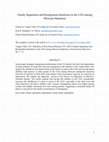
International Migration, 2021
Increasingly stringent immigration enforcement in the US interior has led to the deportation of l... more Increasingly stringent immigration enforcement in the US interior has led to the deportation of large numbers of long-term Mexican immigrants with families in the United States. We analyse the statistical association between the intent to return to the USA and leaving minor children with spouses or other people in the USA among Mexican immigrants deported from the US interior in 2014-2018, and explore if this association varies by sex and year of deportation. We employ the deportees' section of the Survey on Migration on Mexico's Northern Border. The results indicate that having left children in the USA considerably increases the likelihood of a plan to return to the USA, especially in the short term and when deportees left minor children with a spouse. Remigration plans were higher among women and slightly decreased over time among parents, suggesting a continued failure of policy to account for the family circumstances of immigrants..
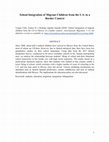
International Migration, 2020
Since 2008, about half a million children have arrived in Mexico from the United States, most of ... more Since 2008, about half a million children have arrived in Mexico from the United States, most of whom are US-born. However, due to limited statistical data, there have been few quantitative studies on their school integration. Using data from the 2017 School Integration Survey-conducted in 86 lower secondary schools in the Tijuana metropolitan area- we analyse the relationship between students' liking of school and their binational school trajectories in this border city with high return migration. The results, based on a multivariate statistical analysis, show that students who studied in that country exhibit a lower liking of school, which correlates with a higher number of years of schooling in the U.S. and less time spent in Mexico since last arrival. Various mediating mechanisms are identified such as limited Spanish proficiency, teacher indifference and lack of cultural identification with Mexico. The implications for education policy are also discussed.
DERECHOS FRAGMENTADOS: ACCESO A DERECHOS SOCIALES Y MIGRACIÓN DE RETORNO A MÉXICO, 2022
Este capítulo tiene como objetivo general plantear los desafíos que los niños y jóvenes retornado... more Este capítulo tiene como objetivo general plantear los desafíos que los niños y jóvenes retornados de Estados Unidos han experimentado para estudiar en México. Con este fin, en primer lugar, se exhiben los diferenciales que estas poblaciones presentan en indicadores educativos clave a nivel nacional, de acuerdo a las edades reglamentarias para cursar los distintos niveles de educación. En segundo lugar, se sintetizan las barreras que los migrantes de Estados Unidos enfrentan para su incorporación y su inclusión en las escuelas de México. Finalmente, se exponen los avances en política pública al respecto y se trazan líneas de acción que podrían desarrollarse a favor de este segmento poblacional.
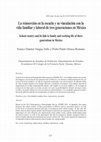
espanolA partir de la Encuesta Demografica Retrospectiva (EDER) 2011, este trabajo analiza los ni... more espanolA partir de la Encuesta Demografica Retrospectiva (EDER) 2011, este trabajo analiza los niveles de reingreso a la escuela de tres generaciones en Mexico y los factores condicionantes de este, asi como el nivel de estudios y el tipo de ocupacion alcanzados con esta inversion. Se utilizan tablas de vida, modelos logisticos de tiempo discreto y estadistica descriptiva. Este trabajo muestra la importancia de la baja intensidad del trabajo, del empleo en el sector publico y de la etapa de crianza de los hijos para el retorno escolar, asi como la posibilidad de obtener un mayor logro escolar y un mejor trabajo tras esta inversion en capital humano. Los resultados apoyan la importancia de politicas educativas encaminadas al regreso a la escuela de la juventud. EnglishBased on the 2011 Retrospective Demographic Survey (EDER 2011, in Spanish), this paper analyzes the school reentry of three generations in Mexico and its associated factors, as well as the level of education attained an...
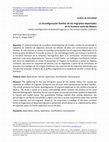
Revista Norteamérica, 2021
El endurecimiento de la política antiinmigrante de Estados Unidos ha provocado la expulsión de mi... more El endurecimiento de la política antiinmigrante de Estados Unidos ha provocado la expulsión de millones de migrantes durante los últimos 20 años con consecuencias para sus familias. En este artículo se analiza la reconfiguración familiar de los migrantes deportados en la frontera norte de México. El estudio se basa en una metodología mixta, que incluye el análisis de la Encuesta Nacional de la Dinámica Demográfica 2014 y 31 entrevistas semiestructuradas aplicadas a personas deportadas en Tijuana y Ciudad Juárez. Los hallazgos cuantitativos indican que entre los deportados es mayor el porcentaje en hogares no familiares y menor en hogares nucleares, que entre los migrantes de retorno y los no migrantes; a partir de las entrevistas, se presenta una tipología de los arreglos familiares más comunes de los migrantes deportados que nos permite entender el efecto de la política migratoria en la separación familiar a través de las fronteras.
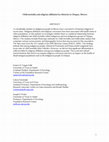
A considerable number of indigenous people in Mexico have converted to Protestant religions in re... more A considerable number of indigenous people in Mexico have converted to Protestant religions in recent years. Religious affiliation and religious conversion have been associated with health status in other populations. In this analysis we investigate whether there is a statistical relationship between religious affiliation and child mortality within indigenous and non-indigenous groups in Chiapas, Mexico. Our analysis includes Brass-type estimates for child mortality and multivariate analysis that comprises various socioeconomic and demographic factors that may account for this association. The data came from the 10% sample of the 2000 Mexican Census (INEGI, 2000). Our findings indicate that among indigenous people, Historical Protestants and Pentecostal-Evangelicals have lower rates of child mortality than Catholics. However, we did not find significant differentials in child mortality by religious affiliation among non-indigenous people. The social and cultural transformations that...
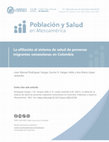
Población y Salud en Mesoamérica, 2021
Introducción: El acceso de las personas migrantes venezolanas al sistema de salud es fundamental ... more Introducción: El acceso de las personas migrantes venezolanas al sistema de salud es fundamental para su supervivencia y bienestar futuro. El objetivo de esta investigación es analizar los niveles de afiliación a dicho sistema de las personas venezolanas en las áreas urbanas de Colombia por periodos de arribo, así como los factores sociodemográficos y laborales asociados. Metodología: Se realiza análisis cuantitativo de tipo estadístico descriptivo e inferencial, a partir de la Gran Encuesta Integrada de Hogares 2018, la cual aporta datos representativos para Colombia y sus 13 ciudades más importantes. Se utilizan los módulos de migración, de variables sociodemográficas del hogar y de ocupación relativos a la población de 14 a 65 años. Resultados: Únicamente 24,5 % de dichos migrantes están inscritos al sistema de salud en contraste a 93 % de las personas colombianas. Los niveles de afiliación se redujeron de 82 % entre las personas venezolanas que arribaron en 2013 o antes a 10 % entre las que llegaron en 2017-2018. Las personas venezolanas afiliadas al sistema de salud son una población selecta en términos sociodemográficos; más joven, más educada, con mayor participación laboral y mayores ingresos que la población nativa en Colombia. La baja inserción de las personas migrantes venezolanas en empleos con contrato escrito restringe dicha afiliación. Conclusiones: Las personas venezolanas en Colombia tienen muy limitada la inscripción al sistema de salud. A pesar de que este es un derecho protegido por los marcos jurídicos internacional y nacional, estas personas enfrentan barreras económicas, políticas y sociales para ejercer ese derecho en Colombia.
In order to accomplish the goals of the study, this chapter is organized in the following manner.... more In order to accomplish the goals of the study, this chapter is organized in the following manner. First of all, we approach the demographic transition in each country, especially the changes in the levels of fertility and mortality, as well as life expectancy of these populations. Next, we describe the shifts in age structure and their implications for the demographic dividend. Afterward, we focus on the volume and composition of the indigenous peoples and selected demographic indicators, the distribution of the populations of each country in urban or rural places and, finally, on their migratory dynamics. We end this chapter underlying the main differences and similarities in the population patterns of both countries, as well as the demographic challenges they face in the advancement of globalization.
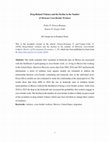
Review of Development Economics, 2020
This study examines how variations in homicide rates in Mexico are associated with the likelihood... more This study examines how variations in homicide rates in Mexico are associated with the likelihood of participating in cross-border work, i.e. living in Mexico but working in the United States. Based on Mexican census data from 2000, 2010 and 2015 and homicide information, a series of ordinary least squares models are estimated to analyse the relationship between cross-border commuting and homicide rates at the individual level. Fixed effects models are also estimated to study this relationship at the municipal level. The results show that from 2000 to 2010 the rise in homicide rates in northern border municipalities in Mexico reduced the likelihood of being a cross-border worker, while from 2010 to 2015 the drop in the homicide rate increased the probability that workers engage in cross-border work. The decline in the number of cross-border workers is likely in part a result of the escalation in drug-related violence which may have led them to change their country of residence.











Uploads
Papers by Eunice D Vargas Valle